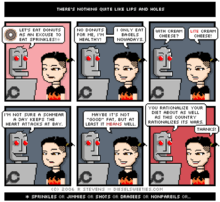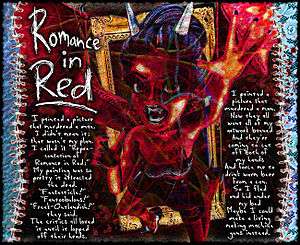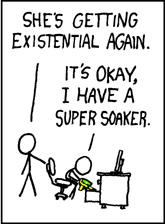Webcomic
| Comics |
|---|
| Comics studies |
| Methods |
| Media |
| Community |
|
|
Webcomics (also known as online comics or Internet comics) are comics published on a website or mobile app. While many are published exclusively on the web, others are also published in magazines, newspapers or in comic books.
Webcomics can be compared to self-published print comics in that anyone with an Internet connection can publish their own webcomic. Readership levels vary widely; many are read only by the creator's immediate friends and family, while some of the largest claim audiences well over one million readers.[1][2][3] Webcomics range from traditional comic strips and graphic novels to avant garde comics, and cover many genres, styles and subjects.[4] They sometimes take on the role of a comic blog.[5] The term web cartoonist is sometimes used to refer to someone who creates webcomics.
Medium


There are several differences between webcomics and print comics. With webcomics the restrictions of the traditional newspapers or magazines can be lifted, allowing artists and writers to take advantage of the web's unique capabilities.
Styles
The freedom webcomics provide allows artists to work in nontraditional styles. Clip art or photo comics (also known as fumetti) are two types of webcomics that do not use traditional artwork. A Softer World, for example, is made by overlaying photographs with strips of typewriter-style text.[6] As in the constrained comics tradition, a few webcomics, such as Dinosaur Comics by Ryan North, are created with most strips having art copied exactly from one (or a handful of) template comics and only the text changing.[7] Pixel art, such as that created by Richard Stevens of Diesel Sweeties, is similar to that of sprite comics but instead uses low-resolution images created by the artist himself.[8] However, it is also common for artists to use traditional styles and layouts, similar to those published in newspapers or comic books.
Content
Webcomics that are independently published are not subject to the content restrictions of book publishers or newspaper syndicates, enjoying an artistic freedom similar to underground and alternative comics. Some webcomics stretch the boundaries of taste, taking advantage of the fact that internet censorship is virtually nonexistent in countries like the United States.[4] The content of webcomics can still cause problems, such as Leisure Town artist Tristan Farnon's legal trouble after creating a homoerotic Dilbert parody,[9] or the Catholic League's protest of artist Eric Millikin's "blasphemous treatment of Jesus."[10]
Format
Webcomics come in a large variation of formats throughout the world. Comic strips, generally consisting of three or four panels, have traditionally been a popular format for webcomics. Other webcomics may mimic the pages of traditional comic books and graphic novels, sometimes in the hopes of eventually being published in print.
Scott McCloud, one of the first advocates of webcomics, pioneered the idea of the "infinite canvas" where, rather than being confined to normal print dimensions, artists are free to spread out in any direction indefinitely with their comics.[11][12] Such a format proved highly successful in South-Korean webcomics when JunKoo Kim implemented an infinite scrolling mechanism in Line Webtoon in 2004.[13] In 2009, French web cartoonist Balak described Turbomedia, a format for webcomics where a reader only views one panel at a time, in which the reader decides their own reading rhythm by going forward one panel at a time.[14] Some web cartoonists, such as political cartoonist Mark Fiore or Charley Parker with Argon Zark!, incorporate animations or interactive elements into their webcomics.[15] There are also attempts to combine comic books presentation with live-action video sequences by Scottish company Rextale.[16]
History
The first comics to be shared through the Internet were created in the mid-1980s. Services such as CompuServe and Usenet were used before the World Wide Web started to rise in popularity in 1993. Early webcomics were usually derivatives from strips in college newspapers, but when the Web became widely popular in the mid-1990s, more people started creating comics exclusively for this medium. By the year 2000, various webcomic creators were financially successful and webcomics became more artistically recognized. Unique genres and styles became popular during this period.
In the second half of the 2000s, webcomics became less financially sustainable due to the rise of social media and consumers' disinterest in certain kinds of merchandise. However, crowdsourcing through Kickstarter and Patreon also became popular in this period, allowing readers to donate money to webcomic creators directly. The 2010s also saw the rise of webtoons in South Korea, where the form has become very prominent. This decade has also seen an increasingly larger number of successful webcomics being adapted into animated series in China and Japan.
Webcomics collectives
In March 1995, Bebe Williams launched the webcomics portal Art Comics Daily, an online gallery of several webcomics.[17]
In March 2000, Chris Crosby, Crosby's mother Teri, and Darren Bleuel founded the webcomics portal Keenspot.[18][19]
In July 2000, Austin Osueke launched eigoMANGA a web portal that published original online manga "webmanga". Within this year, eigoMANGA brought comic book industry attention to webcomics after being featured in many comic book web magazine articles and later appearing in the March 2001 issue of Wizard Magazine.
In 2001, the subscription webcomics site Cool Beans World was launched after a high-profile publicity campaign including extensive print advertising. It won Internet Magazine's "Site of the Month" award in October 2001.[20] Contributors included, amongst others, UK-based comic book creators Pat Mills, Simon Bisley, John Bolton and Kevin O'Neill, and the author Clive Barker.[21] Serialised content included Scarlet Traces and Marshal Law.
In March 2001, Shannon Denton and Patrick Coyle launched Komikwerks.com serving free strips from comics and animation professionals. The site launched with 9 titles including Steve Conley's Astounding Space Thrills, Jason Kruse's The World of Quest and Bernie Wrightson’s The Nightmare Expeditions.
On March 2, 2002, Joey Manley founded Modern Tales, offering subscription-based webcomics.[22] The Modern Tales spin-off serializer followed in October 2002, then came girlamatic and Graphic Smash in March and September 2003 respectively.
By 2005, webcomics hosting had become a business in its own right, with sites such as The Rampage Network and Webcomics Nation.[23]
While comic strip syndicates had been present online since the mid-1990s, traditional comic book publishers, such as Marvel Comics and Slave Labour Graphics, did not begin making serious digital efforts until 2006 and 2007.[24] DC Comics launched its web comic imprint, Zuda Comics in October 2007.[25] The site featured user submitted comics in a competition for a professional contract to produce web comics. In July 2010, it was announced that DC was closing down Zuda.[26]
Business

Creators of webcomics are able to do so professionally through various revenue channels. Webcomic artists may sell merchandise based on their work, such as T-shirts and toys, or they may sell print versions or compilations of their webcomic. Many webcomic creators make use of online advertisement on their websites, and some have undergone product placement deals with larger companies. Crowdfunding through Kickstarter and Patreon have also become sources of income for web cartoonists.
Webcomics have been used by some cartoonists as a path towards syndication in newspapers; however, out of the thousands of comics submitted to each syndicate every year, only a few are accepted. In 2000, Scott McCloud predicted that micropayments would become a major source of income for web cartoonists, but this declaration never came to fruition.
Many webcomic artists started creating their online works without an intention to directly profit from it, often instead publishing through the Internet in order to get (instant) feedback on their skills. Other artists start creating a webcomic with the intention of becoming a professional; many don't succeed in part because they "put the business before the art." Meanwhile, many successful webcomic artists are diversifying their income streams in order to not be solely dependent on the webcomic itself.
Awards
Many webcomics artists have received honors for their work. In 2006, Gene Luen Yang's graphic novel American Born Chinese, originally published as a webcomic on Modern Tales, was the first graphic novel to be nominated for a National Book Award.[27] Don Hertzfeldt's animated film based on his webcomics, Everything Will Be OK, won the 2007 Sundance Film Festival Jury Award in Short Filmmaking, a prize rarely bestowed on an animated film.[28]
Many traditionally print-comics focused organizations have added award categories for comics published on the web. The Eagle Awards established a Favorite Web-based Comic category in 2000, and the Ignatz Awards followed the next year by introducing an Outstanding Online Comic category in 2001. After having nominated webcomics in several of their traditional print-comics categories, the Eisner Awards began awarding comics in the Best Digital Comic category in 2005. In 2006 the Harvey Awards established a Best Online Comics Work category, and in 2007 the Shuster Awards began an Outstanding Canadian Web Comic Creator Award. In 2012 the National Cartoonists Society gave their first Reuben Award for "On-line comic strips."[29]
Other awards focus exclusively on webcomics. The Web Cartoonists' Choice Awards[30][31] consist of a number of awards that were handed out annually from 2001 to 2008. The Clickburg Webcomic Awards (also known as "the Clickies") has been handed out annually since 2005 at the Stripdagen Haarlem comic festival. The awards require the recipient to be active in the Benelux countries, with the exception of one international award.[32]
Webcomics in print
Though webcomics are typically published primarily on the World Wide Web, some web cartoonists may get publishing deals in which comic books are created of their work. Sometimes, these books are published by mainstream comics publishers who are traditionally aimed at the direct market of regional comic books.[33] Some web cartoonists may pursue print syndication in established newspapers or magazines. In other cases, webcomic creators decide to self-publish their work. Crowdfunding through Kickstarter is often used in order to fund such projects.
The traditional audience base for webcomics and print comics are vastly different, and webcomic readers do not necessarily go to bookstores. For some web cartoonists, a print release may be considered the "goal" of a webcomic series, while for others, comic books are "just another way to get the content out."[34] Webcomics have been seen by some artists as a potential new path towards syndication in newspapers, but attempts have rarely proven lucrative. According to Jeph Jacques (Questionable Content), "there's no real money" in syndication for webcomic artists. Some artist would not be able to syndicate their work in newspaper because they fill up a specific niche and wouldn't be accepted by a broader audience.[35]
Non-anglophone webcomics
Many webcomics are published primarily in English, this being a major language in Australia, Canada, India, the United States, and various European countries. Cultures surrounding non-anglophone webcomics have thrived in countries such as China, France, India, Japan and South Korea.
Webcomics have been a popular medium in India since the early 2000s. Indian webcomics are successful as they reach a large audience for free[37] and they are frequently used by the country's younger generation to spread social awareness on topics such as politics and feminism. These webcomics reach a large amount of exposure by being spread through social media.[38]
In China, Chinese webcomics have become a popular way to criticize the communist government and poiticians in the country. Many webcomics by popular artists get shared around the country thanks to social networks such as Sina Weibo and WeChat. Many titles will often be censored or taken down by the government.
See also
References
- ↑ Allen, Todd (27 February 2012). "Rich Burlew Talks About His $1 Million Kickstarter Book Project". Publishers Weekly. Retrieved May 24, 2013.
- ↑ O'Malley, Bryan Lee (October 2, 2012). "'Scott Pilgrim' Guy Interviews 'Homestuck' Guy: Bryan Lee O'Malley On Andrew Hussie". Comics Alliance. AOL. Archived from the original on March 8, 2013. Retrieved May 24, 2013.
- ↑ Geddes, John (April 2, 2010). "'Penny Arcade' a testament to the power of gaming culture". USA Today. Retrieved October 12, 2011.
- 1 2 Lacy, Steven (November 21, 2007). "Webcomics are profane, explicit, humorous — and influencing trends". Charleston City Paper. Noel Mermer. Retrieved November 28, 2009.
- ↑ McGillis, Ian (2015-09-25). "From comic blog to bestseller: Kate Beaton's Step Aside, Pops is the second instalment in a comics publishing phenomenon". Montreal Gazette.
- ↑ Arrant, Chris (April 25, 2006). "It's A Softer World After All". Publishers Weekly. Reed Elsevier. Archived from the original on June 6, 2009. Retrieved 2009-11-28.
- ↑ Rall, Ted (2006). Attitude 3: The New Subversive Online Cartoonists. New York: Nantier Beall Minoustchine Publishing. pp. 115–121. ISBN 1-56163-465-4.
- ↑ Hodges, Michael H. (January 8, 2007). "Diesel Sweeties tackles nuts, bolts of love". The Detroit News. Detroit: Jonathan Wolman. p. 1E.
- ↑ Crane, Jordan (April 2001). "A Silly Little Coat Hanger for Fart Jokes: Talkin' Comics with Leisuretown.com's Tristan A Farnon". The Comics Journal (232): 80–89.
- ↑ "Michigan State President Acts Presidential". Catalyst Journal of the Catholic League for Religious and Civil Rights. Catholic League for Religious and Civil Rights. November 2000. Archived from the original on January 24, 2010. Retrieved November 28, 2009.
- ↑ McCloud, Scott (2000). Reinventing Comics. New York: Paradox Press. pp. 200–233. ISBN 0-06-095350-0.
- ↑ McCloud, Scott (July 2001). "McCloud in Stable Condition Following Review, Groth Still at Large". The Comics Journal (235): 70–79.
- ↑ Acuna, Kristen (2016-02-12). "Millions in Korea are obsessed with these revolutionary comics -- now they're going global". Business Insider.
- ↑ Leroy, Joséphine (2016-03-06). "Balak, auteur et créateur du Turbo Media : "Il y a un marché de la BD numérique"". Actualitte.
- ↑ Rall, Ted (2006). Attitude 3: The New Subversive Online Cartoonists. New York: Nantier Beall Minoustchine Publishing. p. 9. ISBN 1-56163-465-4.
- ↑ "RexTale Productions".
- ↑ Peterson, Iver (October 28, 1996). "The Search for the Next 'Doonesbury". The New York Times, Pg. D9
- ↑ Yim, Roger. (April 2, 2001). "DOT-COMICS: Online cartoons skip traditional syndication and draw loyal fans on the Internet". San Francisco Chronicle. Pg. D1
- ↑ Newman, Heather. (February 2, 2001). "See You In The Funny Pixels Michigan Cartoonists Draw On Web Sites To Find Readers". Detroit Free Press. Pg. 1H
- ↑ Rogers, Jean. "Comics and New Media". Retrieved 2007-03-15.
- ↑ Martin, Jessica. "Cool Beans or Dead Beans: can the comic barons cross onto the web?". Archived from the original on October 18, 2006. Retrieved 2007-03-15.
- ↑ Ho, Patricia Jiayi (July 8, 2003). "Online comic artists don't have to play panel games". Alameda Times-Star (Alameda, CA)
- ↑ Walker, Leslie (June 16, 2005). "Comics Looking to Spread A Little Laughter on the Web". The Washington Post, p. D1.
- ↑ Soponis, Trevor. "Publishers Look to Digital Comics". Publishers Weekly. Archived from the original on January 27, 2007. Retrieved 2007-05-02.
- ↑ "PERAZZA ON THE LAUNCH OF ZUDACOMICS.COM". Archived from the original on March 5, 2010.
- ↑ Perazza, Ron (July 1, 2010). "The Future of Zuda". The Bleed. DC Comics.com. Retrieved July 1, 2010.
- ↑ Bosman, Julie. (October 12, 2006). "National Book Award Finalists Chosen". The New York Times, Pg. E2
- ↑ De Benedetti, Chris. "Bay Area films keep it real at Sundance festival". Oakland Tribune. Retrieved 2007-01-16.
- ↑ "National Cartoonists Society".
- ↑ Boxer, Sarah (2005-08-17). "Comics Escape a Paper Box, and Electronic Questions Pop Out". New York Times.
- ↑ "Attack of the Show" Archived April 4, 2016, at the Wayback Machine.. G4TechTV. Aired August 12, 2005.
- ↑ Mirk, Jeroen. "comicbase.nl's blog". Comixpedia. Archived from the original on June 15, 2006. Retrieved 2007-01-31.
- ↑ Wolk, Douglas (2004-11-01). "Web Comics Send Readers Looking for Books". Publishers Weekly.
- ↑ McDonald, Heidi (2005-12-19). "Web Comics: Page Clickers to Page Turners". Publishers Weekly.
- ↑ Chen, Jialu (2011-09-02). "See you in the funny pages". The Boston Globe.
- ↑ Zlatkovský, Michal (2013-09-23). "Opráski sčeskí historje na IHNED.cz: Jak Češi volili Husákovu KSČ". Hospodářské noviny.
- ↑ Arora, Kim (2010-09-05). "Strip tease: Indian webcomics make a mark". The Times of India.
- ↑ Verma, Tarishi (2015-04-26). "Laughing through our worries: The Indian web comics". Hindustan Times.
External links
| Wikimedia Commons has media related to Webcomics. |
| Look up webcomic in Wiktionary, the free dictionary. |
- The Rise of Web Comics Video produced by Off Book (web series)

